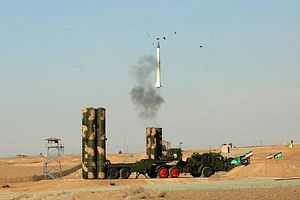The Iranian Air Defense Force (IADF) has successfully conducted a test of its newly acquired S-300PMU-2 Favourite long-range surface-to-air missile (SAM) air defense system, Iranian state media reported on March 4.
The missile drill, dubbed Damavand, involved a simulated ballistic missile attack under electronic warfare conditions to test the S-300’s electronic warfare countermeasures and its ability to detect, track, and intercept targets under electronic warfare conditions. The missile defense drill was attended by senior military commanders and officials and overseen by the commander of the IADF, General Farzad Esmaili.
According to the general, an interceptor missile fired from a transporter erector launcher successfully destroyed an incoming target simulated a ballistic missile with a small radar cross-section. It is neither clear how many missiles were test fired nor at what altitude the targets (which purportedly also included a drone) were intercepted. However, at the conclusion of the drill, the general announced that the S-300 air defense system is now operational.
In January 2015, Iran and Russia agreed to move forward with the sale of five S-300 battalions for an estimated $800 million, following the resolution of a year-long dispute over a cancelled June 2010 order of S-300 air defense systems as a result of UN-imposed sanctions on Iran. Delivery of the first batch of S-300s, an upgraded variant of the air defense system initially ordered by Iran in 2010, began in April 2016. All five battalions were delivered by the end of the same year, although it remains unclear what missile types Russia has sold to Iran. As I explained elsewhere:
Next to a number of shorter range missiles, the S-300 batteries are usually armed with the 48N6E, a vertical tube launched, solid fuel, single stage SAM with an estimated range of 150 kilometers (93 miles). The S-300 air defense systems could also be equipped with an upgraded variant of the 48N6E (…)
In comparison to the S-300-PMU1 system, the upgraded PMU2 variant can engage both short-range ballistic missiles as well as medium-range tactical ballistic missiles. With the new 48N6E2 missile, the effective range of the SAM complex extends to about 195 kilometers (121 miles). (…) Some analysts believe that the 48N6E2 missile is compatible with older S-300 SAM systems.
A Russian battalion can comprise up to 16 transporter erector launchers (TEL), divided into four batteries, in addition to fire-control radars and a command/fire and control post. Each TEL carries four tubes with one SAM per tube. However, it is unclear how many TELs have been delivered to Iran–the originally contract signed in 2007 stipulated 40 TELs plus an unknown number of missiles–some sources indicate a total of 60 TELs delivered in 2016. As I reported in August 2016, Iran deployed an unknown number of S-300 batteries around the Fordow nuclear site located 100 kilometers (60 miles) south of Tehran to defend the underground nuclear facility against air strikes.
































